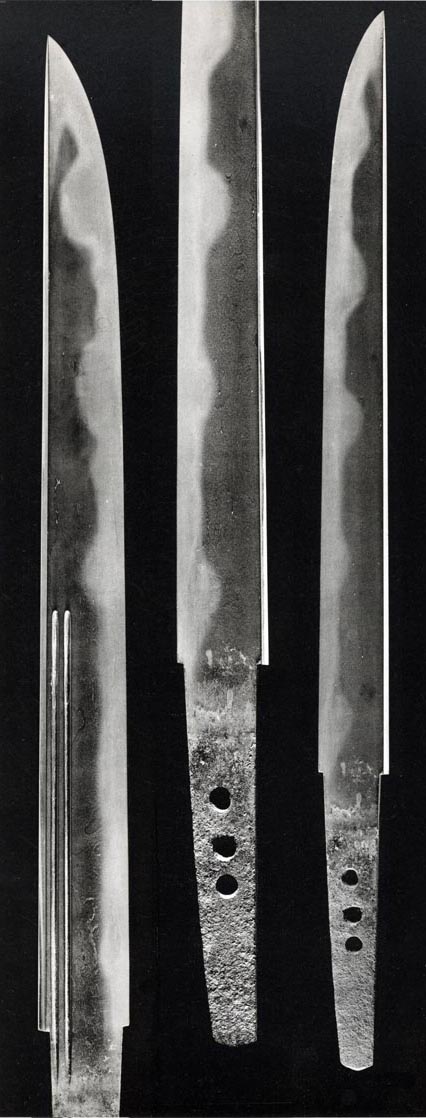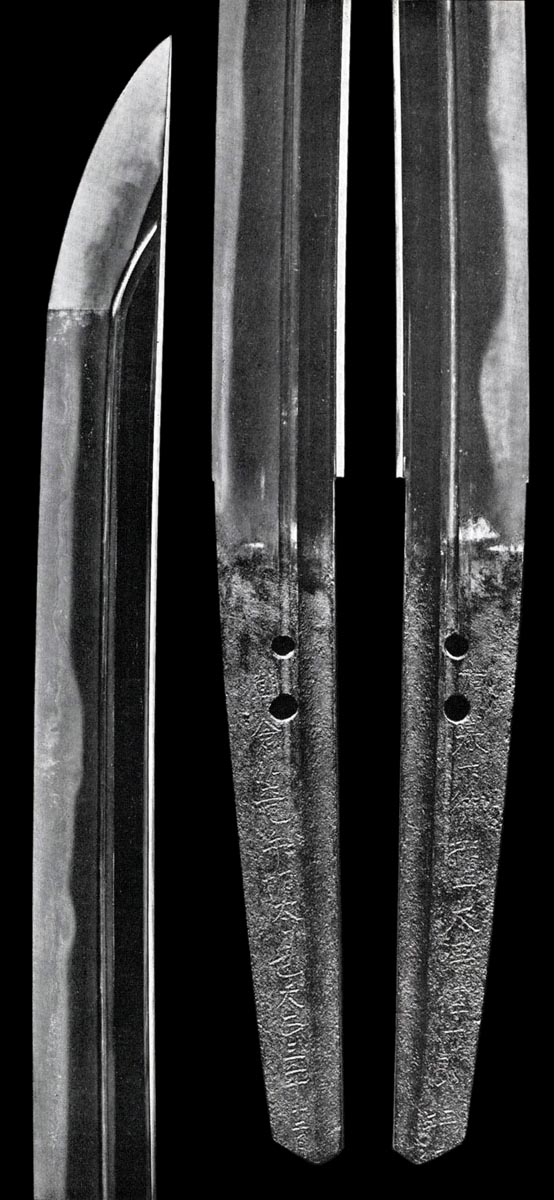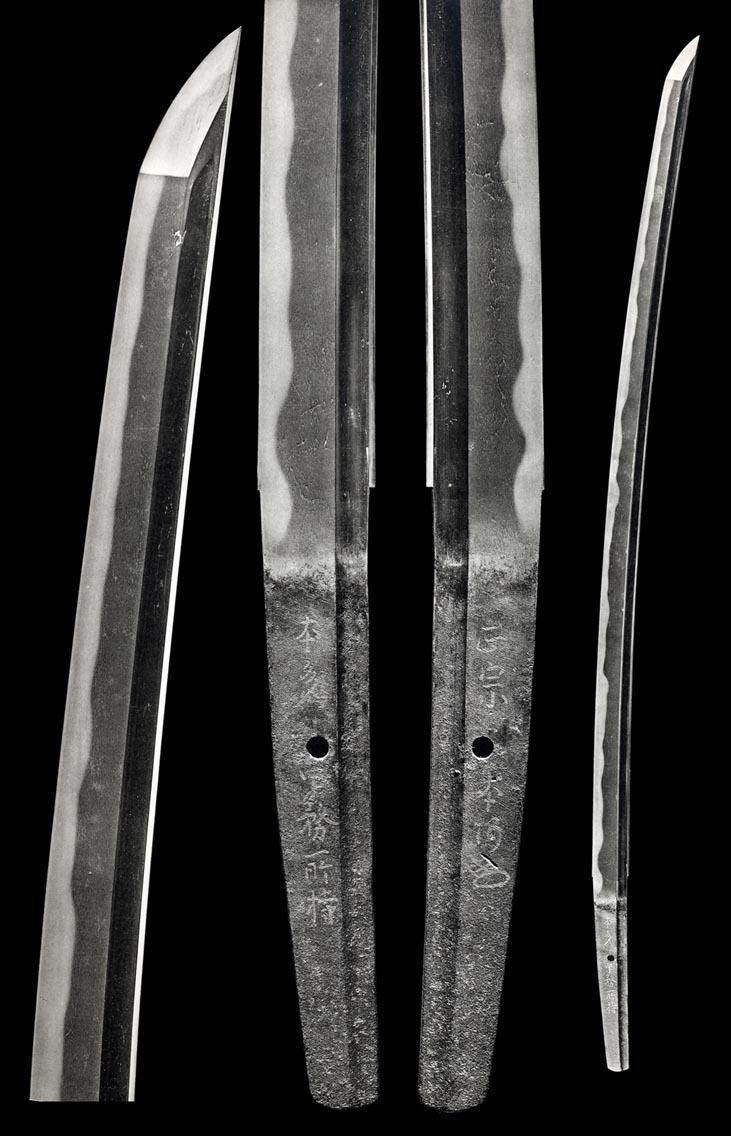©
Copyright
Robert Cole
2015
- No copying
or
distributing
Masamune
__________________________________________
Sword
Making at YAMANOUCHI
|
 

|
|

MASAMUNE SHO-SO to KA-REKI Born: 1264, died: 1343 (t: SHINTOGO): OKAZAKI-GORO.
Late-KAMAKURA/Early-NAMBOKUCHO SUGATA. Forever known as the greatest
SOSHU sword smith. His reputation trumpeted by all authorities from all
times and all sources. He made TACHI and TANTO. ZAIMEI (signed) TANTO
are found, TACHI are almost always MUMEI or O-SURIAGE NAKAGO and
therefore without signature. All swords, like paintings, are validated
by the work, not by signature. TANTO can be expected between 7 Sun and
9. He enjoyed producing a wide MIHABA SUGATA. His swords are strong.
Early were 7 Sun KOFURI UCHIZORI with FURI-SODE NAKAGO.
Later, we see more MU-SORI NAKAGO.
SUGATA: His time, and the swords they made, walked from Late-KAMAKURA
SUGATA, to Late-KAMAKURA/Early-NAMBOKUCHO SUGATA and then to the fully
developed O-KISSAKI NAMBOKU SUGATA. He was born at the end of Mid-
KAMAKURA, lived into the NAMBOKUCHO.
Remember, a late KAMAKURA SUGATA is a normal SHINOGI-TSUKURI NIHONTO
shape compared to the coming NAMBOKUCHO SUGATA of long, wide, straight
with large O-KISSAKI. The transition shows a graceful curve, wider in
the mid and reaching for an elongated KISSAKI. It almost appears subtly
similar to the famous SOSHU TANAGO NAKAGO.
MUNE: MITSU-MUNE and IHORI-MUNE. His MUNE will be shallow, or not
highly raised.
He created his TANAGO "Fish-Belly" NAKAGO to be uniquely swept back to
a small KENGYO or YAMAGATA-shaped JIRI. His TANAGO NAKAGO are
tastefully stylized and not exaggerated. A few TANTO appear KURIJIRI
but may not have been originally. Even small TANTO with a relatively
straight tang, smoothly resolve to a small JIRI. NAKAGO-MUNE may have
a very slight NIKU. His well-shaped TANAGO-NAKAGO were a consistent
statement to his SOSHU school position.
JI-TETSU is KO-ITAME where HADA runs to the point where, in some pieces
has been called O-Mokume. There is JI-NIE and can appear as NIE-UTSURI.
The KITAE has CHIKEI and NIE in various places. It is famous that his
thinner blade allowed a greater abundance of surface NIE and YUBASHIRI
effects, such as TOBI-YAKI and grouping NIE.
Special MASAMUNE Note: CHIKEI can be strewn through the steel. At
times, abundant dark CHIKEI is seen twisting in the grain and gives
the Jitetsu the appearance of Lace Agate.
HAMON is generally NIE-DEKI, NOTARE GUNOME patterns where MIDARE
unevenness is taken to the extreme. His figures are dynamic storms.
NIE can be MURA-NIE and NIOI is FUKASHI or deep. YO or TOBI can be
seen.
Early work was influenced by SHINTOGO KUNIMITSU, where KO-NIE DEKI
on HOSO-SUGUHA, KO-MARU BOSHI. YAKIDASHI flares up near the MUNE in
a manner to mimic SHINTOGO.
Then we see KO-MIDARE BA and SUGU ASAKI-NOTARE, gently undulating
HAMON line, and the rise of his SOSHU GUNOME-MIDARE special trait of
wildly oblong and stretched figures. MIMIGATA GUNOME O-MIDARE BA
shrouded under NIE and NIOI with KINSUJI and INAZUMA arcing through
the grain. KINSUJI can be particularly bright.Some swords show a long
SUGUHA line that becomes ever wider toward the upper, in NIE.
BOSHI can be MIDARE-KOMI or TSUKI-AGE with shallow KAERI. He can show
an active O-MARU BOSHI that will be covered with NIE or NIE HAKIKAKE
and with KINSUJI.
MASAMUNE YASURI is KATTE-SAGARI.
MASAMUNE
MASAMUNE SAKU
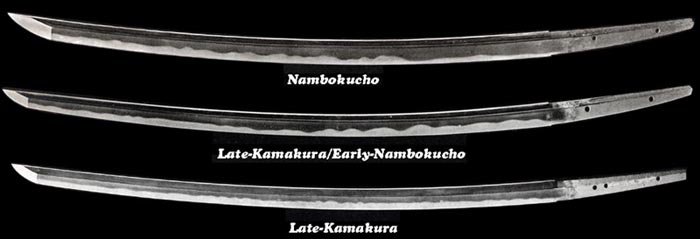
Dark
CHIKEI defines wildly forged steel
Don't
Forget...
|
|
|
Meibutsu
Jo Izumi-no-Kami Shoji Masamune -
Kokuho
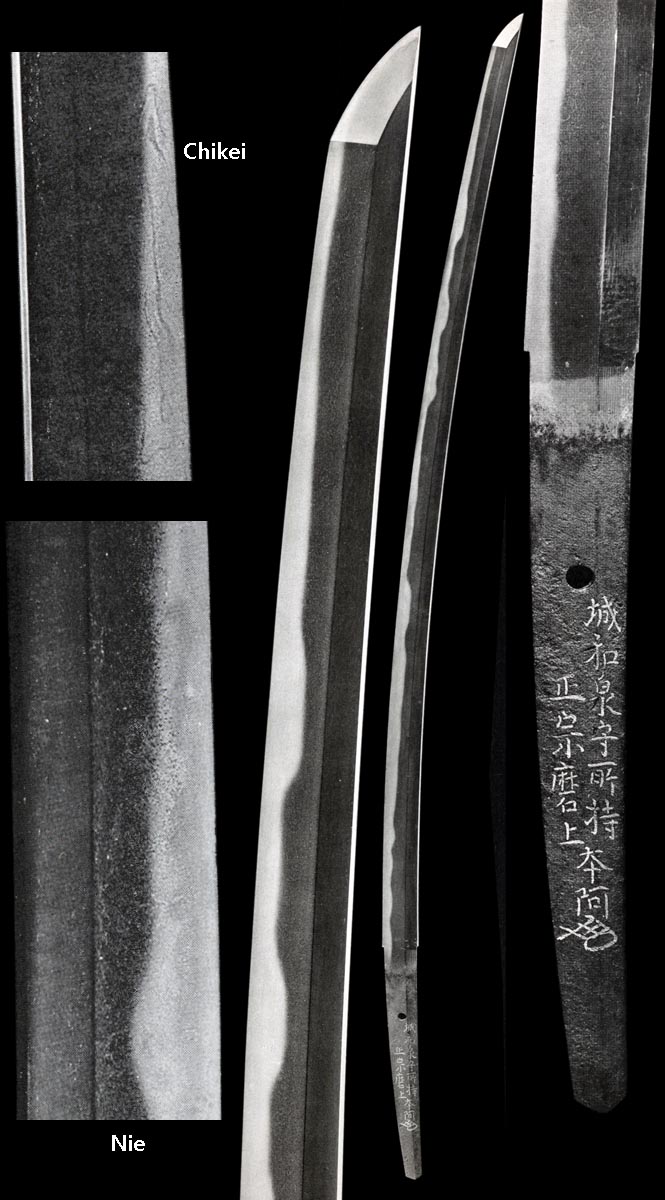
Meibutsu
Jo
Izumi-no-Kami
Shoji
Masamune
Nagasa:
2 Shaku 3 Sun 3 Bu
(70.6cm)
Sori: 7 Bu (2.12cm)
Moto-haba: 8 Bu 8
Rin (2.67cm)
Saki-haba: 5 Bu 8
Rin (1.76cm)
Kissaki-naga: 9 Bu 6
Rin (2.91cm)
Moto-kasane: 2 Bu
(0.61cm)
Saki-kasane Just
over 1 Bu (0.45cm)
Nakago: 5 Sun 8 Bu
(17.6cm)
Nakagozori: 5 Rin
(0.15cm)
Considered
the highest
stroke of
Soshu art. The
forging
created very
hard steel,
with strongly
standing
Chikei as a
theme.
Brilliantly
shining Nie
strikingly and
unmistakably
states its
author.
Shinogi-tsukuri,
Ihori-mune, deeply
curved and with
Chu-Kissaki.
Itame Hada has Ji-Nie
and its abundant Chikei.
Notare Ko-Choji with
Ko-Ashi and Ko-Gunome
mixed with Yubashiri.
KoAshi-iri falls under
flowing Sunagashi where
Nie-Kori stands like
fruit. Kinsuji wrestles
Chikei for place.
Midare Boshi has Kinsuji
and resolves in
Yakizumi.
O-Suriage Kengyo-Jiri
Sujichigai Yasuri
Kinzogan-Mei: Jo
Izumi-no-Kami (Masashige)
Shoji
Masamune Suriage - Honami
Kotoku - Cao |
|
Meibutsu
Taro-saku Masamune
Kokuho
|
Masamune
Kitae shows strongly made Chikei
|
Meibutsu
Taro-saku Masamune
Nagasa: 2 Shaku 1 Sun 2 Bu 2 Rin (64.3cm)
Sori: 5 Bu 9
Rin (1.8cm)
Moto-haba: 1
Sun 2 Rin
(3.1cm)
Saki-haba: 8
Bu 3 Rin
(2.5cm)
Kissaki-naga:
1 Sun 3 Bu 5
Rin (4.1cm)
Moto-kasane: 2
Bu (0.61cm)
Saki-kasane
Just over 1 Bu
6 Rin (0.5cm)
Nakago: 5 Sun
6 Bu 4 Rin
(17.1cm)
Slight
Nakagozori
Shinogi-tsukuri,
Mitsu-mune,
wide body,
Bo-Hi and with
strong
Chu-Kissaki.
Itame Hada has Ji-Nie and
Chikei, dappling through the
Ji.
Ko-Midare Ba in an
Asaki-Notare, gently
undulating, line. Chikei
dances in Kitae while Kinsuji
and Nie dress the Hamon.
Midare-Komi Boshi has short
Kaeri.
O-Suriage with shallow
Kurijiri.
|
|
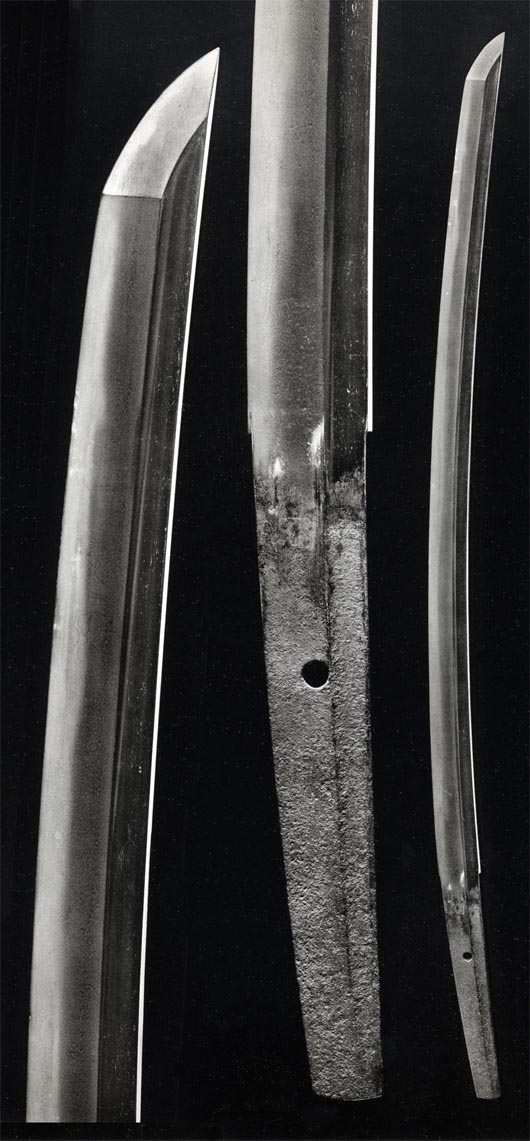
|
|
Meibutsu
Kanze Masamune - Kokuho
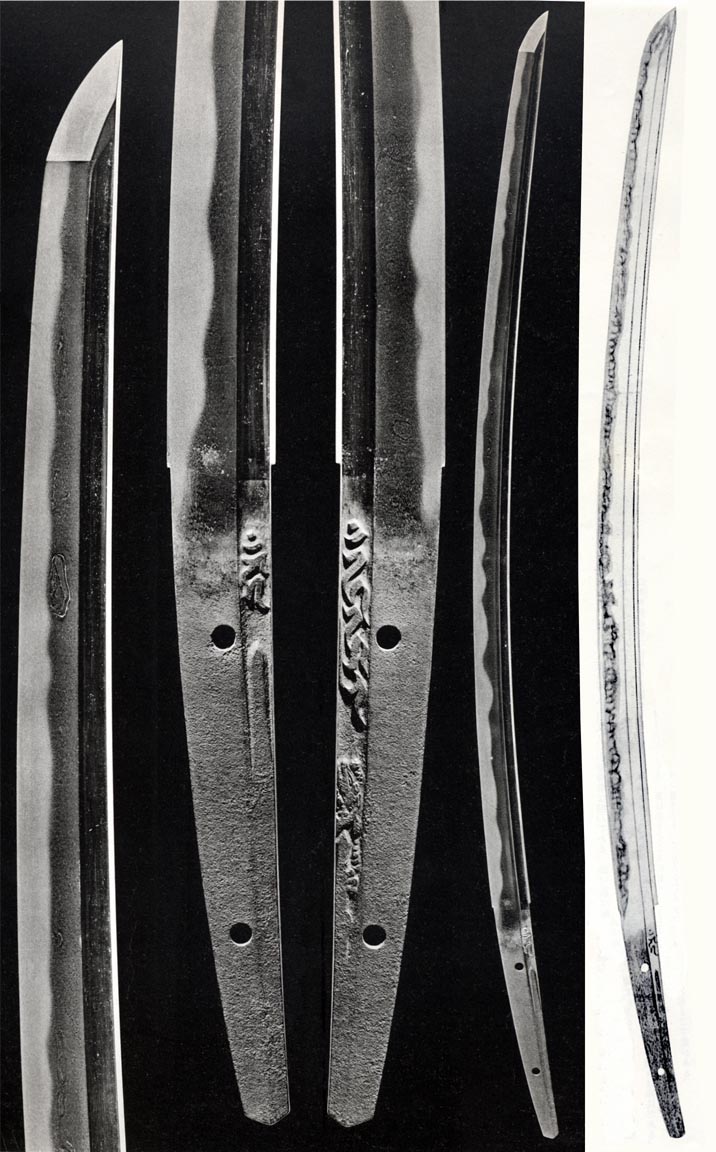
Meibutsu
Kanze Masamune
Nagasa: 2
Shaku 1 Sun 2 Bu (64.39cm)
Sori: 6 Bu (1.82cm)
Moto-haba: 9 Bu 3 Rin (2.8cm)
Saki-haba: 5 Bu 6 Rin (1.7cm)
Kissaki-naga: 9 Bu 6 Rin
(2.91cm)
Nakago: 5 Sun 4 Bu 8 Rin
(16.6cm)
Small Nakagozori
Shinogi-tsukuri, Ihori-mune to
Chu-Kissaki.
Itame Hada with Ji-Nie and Chikei
bunch together across the surface.
Ko-Midare and Ko-Gunome push each
other. Ashi cuts figures while Yo
alights. Kinsuji knifes through
flowing Sunagashi.
Midare-Komi Boshi is brushed with
flaring Ji-Nie and Kinsuji.
Horimono are Bonji, Kurikara and Ken.
Two-Mekugi-ana to Kengyo-Jiri
|
|
Meibutsu
Ishida Masamune - Juyo
Bunkazai
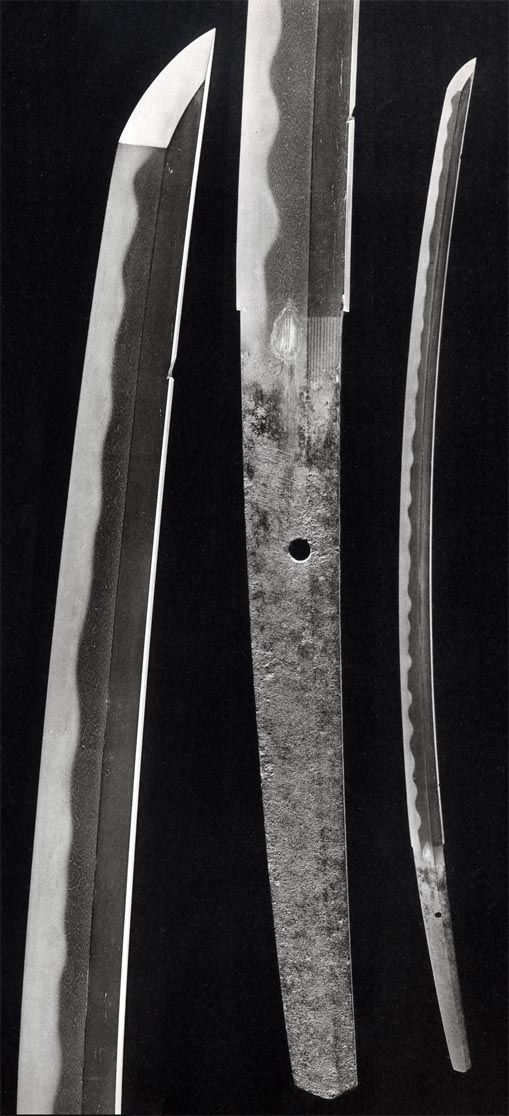
Meibutsu
Ishida Masamune
Sword of Ishida Kazushige -
Implacable foe of Iyeyasu
Nagasa: 2
Shaku 2 Sun 7
Bu (68.98cm)
Sori: 8 Bu 2
Rin (2.48cm)
Moto-haba: 9
Bu 2 Rin
(2.79cm)
Saki-haba: 7
Bu (2.12cm)
Kissaki-naga:
1 Sun 5 Rin
(3.18cm)
Nakago: 6 Sun
5 Bu (19.7cm)
Gentle
Nakagozori
Shinogi-tsukuri,
Ihori-mune,
strongly curved
with
Chu-Kissaki. Two
Battle-scars.
Tightly forged
Ko-Itame Hada
has Ji-Nie and
the always
Masamune mark:
Chikei.
Notare line has
Gunome mixed,
with Ashi, Yo
and Kinsuji
running in
Sunagashi.
Midare-Komi
Boshi turns in
Ko-Maru with
Hakikake.
O-Suriage Kengyo
Nakago, one
Mekugi-ana.
|

|
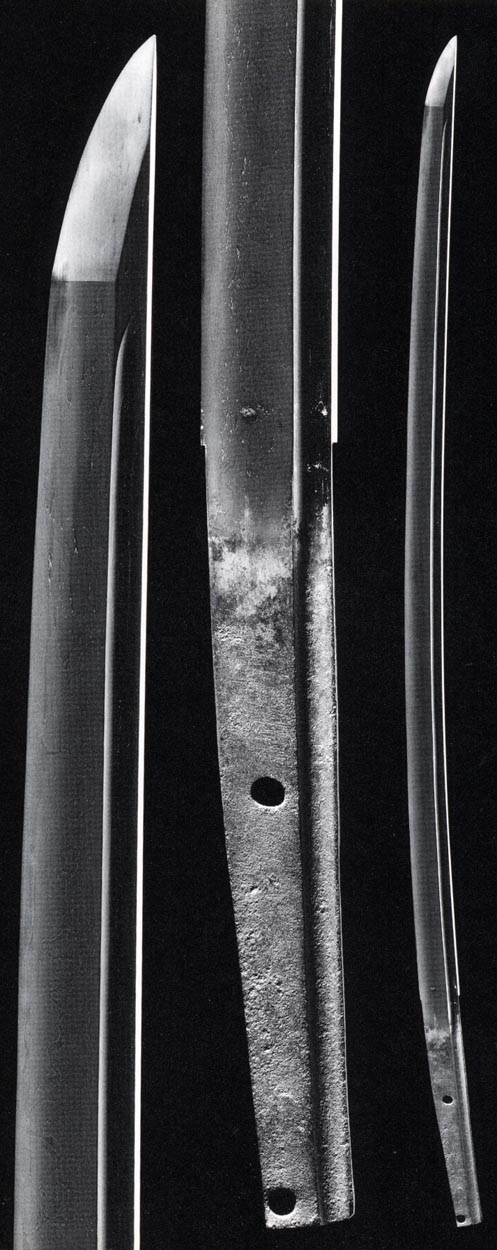
Meibutsu
Musashi Masamune
First a possession of the
Tokugawa Shogunate, then famous
of the Kishu Tokugawa.
Itame Hada with thick Ji-Nie and
Chikei interspersed through the
Hada. Bo-Hi Horimono.
Undulating Notare line of
Gunome, Choji O-Midare Ba with
Kinsuji, Sunagashi and very
strong Tsuyo Nie. Ashi and Yo.
Eboshi Ceremonial-Hat Jizo style Boshi with
slight
Hakikake.
O-Suriage
Kirijiri Nakago with two
Mekugi-ana.
|
|
Meibutsu
Chida Masamune - Juyo
Bunkazai
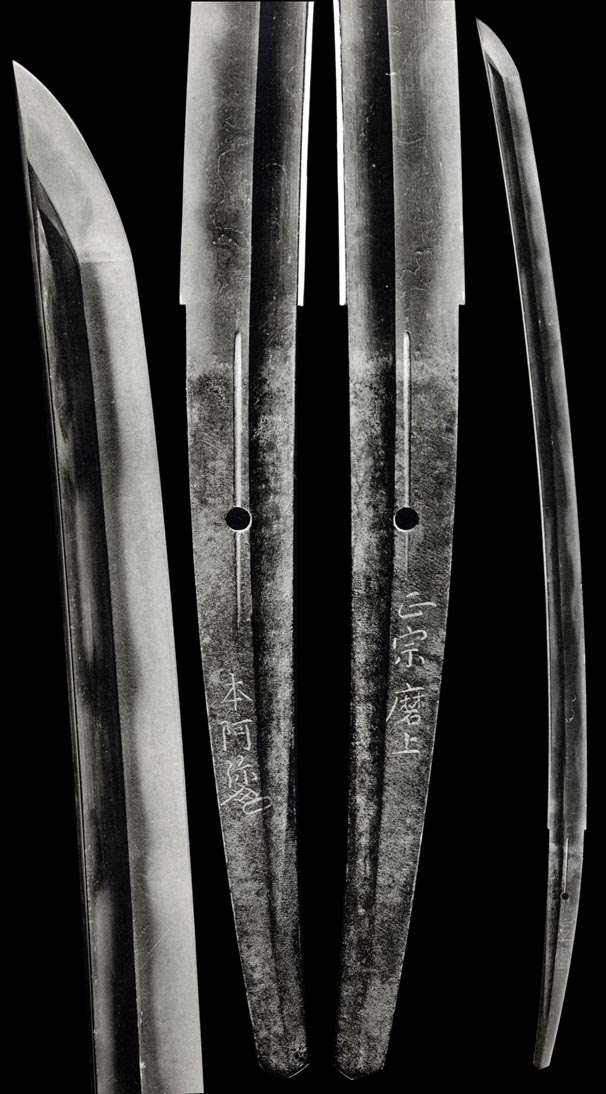
Meibutsu
Chida Masamune
Nagasa: 2 Shaku 2 Sun 1 Bu (66.96cm)
Sori: 6 Bu
(1.82cm)
Motohaba: 1
Sun (3.03cm)
Saki-haba: 8
Bu 5 Rin
(2.28cm)
Moto-kasane: 2
Bu 3 Rin
(0.7cm)
Saki-kasane: 2
Bu (0.61cm)
Nakago: 6 Sun
5 Bu (19.7cm)
Small
Nakagozori
Very
strong, wide bodied Shinogi
Tachi with shallow Sori and
O-Kissaki. Large Shinogi-wide
Bo-Hi Sugata.
Strongly standing Itame Hada
flies his unmistakable Ji-Nie
and Chikei banner.
Brilliant Ko-Nie O-Notare Gunome
mix shows Kinsuji, Sunagashi and
Tobiyaki.
Midare-Komi Hakikake Boshi has
small Ko-Maru and short Kaeri.
O-Suriage Nakago to soft
Kengyo-Jiri. One Mekugi-ana.
Kinzogan-Mei:
Masamune Suriage
Honami Kotoku - Cao
|
|

